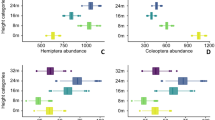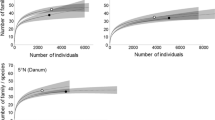Abstract
Canopy disturbance is a major factor affecting forest structure and composition and, as a result of habitat alterations, can influence insect communities. We initiated a field study to quantify the effects of canopy disturbance on aerial insect abundance and distribution within a bottomland hardwood forest along the Cache River, Arkansas, USA. We used passive flight-intercept traps to sample insects in canopy gap and forest interior habitats from May to July in 1996, 1997, and 1998. The hydrologic conditions of our study site varied among years: 1996 was relatively dry, 1997 incurred a long-duration flood, and 1998 was moderately wet. Of the 34,000+ Homopterans collected, many groups were distributed in a non-uniform manner among years and between habitats. Total Homopterans, two families of Homopterans, and six morphospecies were more abundant in canopy gaps than interior forest. Many Homopteran taxa were least abundant in 1997 following almost six months of flooding. Alternatively, relatively large Homopteran abundances were associated with the dry conditions of 1996 and the moderately wet conditions of 1998. Differences in Homopteran abundance among years and habitats may be related to differences in vegetation density. Canopy gaps supported more vegetation cover than the interior forest in all but the first sampling interval. In addition, similar to Homopteran abundance, vegetation density was lower in 1997 than in 1998. These results demonstrate that natural disturbance and flooding contribute to Homopteran abundance and distribution patterns in bottomland hardwood forests of the south central United States.
Similar content being viewed by others
Literature Cited
Andrewartha, H. G. and L. C. Birch. 1984. The Ecological Web. University of Chicago Press, Chicago, IL, USA.
Cumber, R. A. 1952. Studies on Oliarus atkinsoni Myers (Hem. Cixiidae), vector of the yellow-leaf disease of Pharmium tenax Forst. II. The nymphal instars and seasonal changes in the composition of nymphal populations. New Zealand Journal of Science & Technology, B. 34:160–165.
Cumber, R. A. 1953. Studies on Oliarus atkinsoni Myers (Hem. Cixiidae), vector of the yellow-leaf disease of Pharmium tenax Forst. II. Resistance of nymphal forms to submergence-control by inundation. New Zealand Journal of Science & Technology, B. 34:260–266.
Duffy, W. G. and R. A. LaBar. 1994. Aquatic invertebrate production in southeastern USA wetlands during winter and spring. Wetlands 14:88–97.
Gist, C. S. and R. A. Risley. 1982. Role of Insects in the Nutrient Dynamics of the Okefenokee Swamp. Oak Ridge Associated Universities, Oak Ridge, TN, USA.
Gladden, J. E. and L. A. Smock. 1990. Macro-invertebrate distribution and production on the flood plains of two lowland headwater streams. Freshwater Biology 24:533–45.
Godfrey, R. K. and J. W. Wooten. 1981a. Aquatic and Wetland Plants of the Southeastern United States. Dicotyledons. University of Georgia Press. Athens, GA, USA.
Godfrey, R. K., and J. W. Wooten. 1981b. Aquatic and Wetland Plants of the Southeastern United States. Monocotyledons. University of Georgia Press, Athens, GA, USA.
Goff, C. C. 1952. Flood plain animal communities. American Midland Naturalist 47:479–486.
Hacker, H. 1925. The life history of Oliarus felis Kirk. (Homoptera). Memoirs of the Queensland Museum 8(II):113–114.
Hall, R. B. W. and P. A. Harcombe. 1998. Flooding alters apparent position of floodplain saplings on a light gradient. Ecology 79:847–855.
Hamilton, D. B. 1982. Plant succession and the influence of disturbance in the Okefenokee Swamp, Georgia. Ph.D. Thesis. University of Georgia, Athens, GA, USA.
Hill, D. S. 1994. Agricultural Entomology. Timber Press, Inc., Portland, OR, USA.
Janzen, D. H. 1987. Insect diversity of a Costa Rican dry forest: why keep it, and how. Biological Journal of the Linnean Society 30:343–356.
Johnson, M. D. 2000. Evaluation of an arthropod sampling technique for measuring food availability for forest insectivorous birds. Journal of Field Ornithology 71:88–109.
King, S. L. and T. J. Antrobus. 2001. Canopy disturbance patterns in a bottomland hardwood forest in northeast Arkansas. USA. Wetlands 21:543–553.
Long, K. S. and J. M. Nestler. 1996. Hydroperiod changes as clues to impacts on Cache River riparian wetlands. Wetlands 16:379–396.
O’Brien, L. B., M. B. Stoetzel, and D. R. Miller. 1991. Chapter 30: Order Homoptera. In F. W. Stehr (ed.) Immature Insects, vol. 2. Kendall/Hunt Publishing Company, Dubuque, IA, USA.
Orians, G. H. 1980. Some Adaptations of Marsh-nesting Blackbirds. Princeton University Press, Princeton, NJ, USA.
Parsons, K. and C. H. Wharton. 1978. Macroin vertebrates of pools on a piedmont river floodplain. Georgia Journal of Science 36:25–33.
Pechmann, J. H. K. 1981. The effects of flooding on the density, diversity, and biomass of old-field Arthropod guilds: a subsidystress response. M.S. Thesis. University of Georgia, Athens, GA, USA.
Pierson, E. D. 1998. Tall trees, deep holes, and scarred landscapes: conservation biology of North American bats. p. 309–325. In T. H. Kunz and P. A. Racey (eds.) Bat Biology and Conservation. Smithsonian Institution Press, Washington, DC, USA and London, UK.
Porter, K. G., A. Bergstedt, and M. C. Freeman. 1999. The Okefenokee Swamp: invertebrate communities and foodwebs. p. 121–135. In D. P. Batzer, R. B. Rader, and S. A. Wissinger (s.) Invertebrates in Freshwater Wetlands of North America: Ecology and Management. John Wiley & Sons, Inc., New York, NY, USA.
Poulson, T. L. and W. J. Platt. 1989. Gap light regimes influence canopy tree diversity. Ecology 70:553–555.
Rader, R. B. 1999. The Florida Everglades: natural variability, invertebrate diversity, and foodweb stability. p. 25–54. In D. P. Batzer, R. B. Rader, and S. A. Wissinger (eds.) Invertebrates in Freshwater Wetlands of North America: Ecology and Management. John Wiley & Sons, Inc., New York, NY, USA.
Riedell, W. E. and G. R. Sutter. 1995. Soil moisture and survival of western corn rootworm larvae in field plots. Journal of the Kansas Entomology Society 68:80–84.
Shapiro, J. P., D. G. Hall, and R. P. Niedz. 1997. Mortality of the larval root weevil Diaprepes abbreviatus (Coleoptera: Curculionidae) in simulated flooding. Florida Entomologist 80:277–285.
Sjoberg, K. and K. Danell. 1982. Feeding activity of ducks in relation to diet emergence of chironomids. Canadian Journal of Zoology 60:1383–1387.
Sklar, F. H. 1985. Seasonality and community structure of the backwamp invertebrates in a Louisiana cypress-tupelo wetland. Wetlands 5:69–86.
Sutter, G. R., J. R. Fisher, N. C. Elliott, and T. F. Branson. 1990. Effect of insecticide treatments on root lodging and yields of maize in controlled infestations of western corn rootworms (Coleoptera: Chrysomelidae). Journal of Economic Entomology 83:2414–2420.
Uetz, G. W., K. L. Van Der Laan, G. F. Summers, P. A. Gibson, and L. L. Getz. 1979. The effects of flooding on floodplain arthropod distribution, abundance and community structure. American Midland Naturalist 101:286–299.
Wharton, C. H., V. W. Lambour, L. Newsom, P. V. Winger, L. L. Gaddy, and R. Mancke. 1981. The fauna of bottomland hardwoods in southeastern United States. p. 87–160. In J. R. Clark and J. Benforaco (eds.) Wetlands of Bottomland Hardwood Forests. Elsevier, Amsterdam, The Netherlands.
Wigley, T. B. and R. A. Lancia. 1998. Wildlife communities. p. 205–236. In M. G. Messina and W. H. Conner (eds.) Southern Forested Wetlands: Ecology and Management. Lewis Publishers, Boston, MA, USA.
Wissinger, S. A. 1999. Ecology of wetland invertebrates: synthesis and applications for conservation and management. p. 1043–1086. In D. P. Batzer, R. B. Rader, and S. A. Wissinger (es.) Invertebrates in Freshwater Wetlands in North America: Ecology and Management. John Wiley and Sons, Inc., New York, NY, USA.
Author information
Authors and Affiliations
Corresponding author
Rights and permissions
About this article
Cite this article
Gorham, L.E., King, S.L., Keeland, B.D. et al. Effects of canopy gaps and flooding on homopterans in a bottomland hardwood forest. Wetlands 22, 541–549 (2002). https://doi.org/10.1672/0277-5212(2002)022[0541:EOCGAF]2.0.CO;2
Received:
Revised:
Accepted:
Issue Date:
DOI: https://doi.org/10.1672/0277-5212(2002)022[0541:EOCGAF]2.0.CO;2




